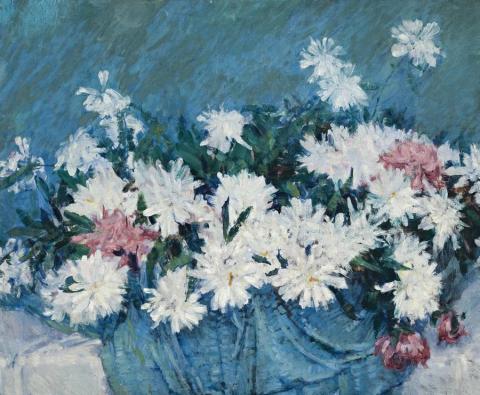PIVOINES BLANCHES, c.1886-88 (WHITE PEONIES)
JOHN PETER RUSSELL
oil on canvas
60.5 x 73.0 cm
printed and written label attached verso, GALERIE G. DENIS 33, RUE DE MIROMESNIL [sic]/PARIS -8e/Auteur John Russell/Dimension 20F/Sujet: Pivoines Blanches/Date: no 34)
The artist's daughter, Jeanne Jouve, France
Galerie G. Denis, Paris (label attached verso)
Possibly Wildenstein Gallery, London
Joseph Brown Gallery, Melbourne, c.1967-68
Private collection, Melbourne, c.1967-68
Deutscher~Menzies, Melbourne, 25 April 1999, lot 92
Private collection, Melbourne
Pivoines, c1886-87, Collection Museé Rodin, Paris
Pivoines sur fond bleu, c1888-90, Private collection, Brisbane
There is a quality about flower painting that derives from the artist's endeavour to capture the unrivalled beauty of nature for, as the Bible says, 'even Solomon in all his glory was not arrayed like one of these.'1 The list of nature's rivals in paint is long and impressive, including the names of many a master from classical antiquity to the present. For the Australian-born John Peter Russell his rivals were also Claude Monet, Vincent van Gogh and their contemporaries. His work stands proud in their company. Russell met Van Gogh soon after he arrived in Paris in 1886. Lack of funds prevented Van Gogh from hiring a model, so he turned to painting flowers giving him the opportunity to introduce more lively colour into his work. He used these numerous flower paintings as 'colour studies'... 'Trying to render intense colour and not a grey harmony.'2 Peonies often added a bright touch of white to his vases of poppies, daisies and cornflowers, examples of which are found in the collection of the Rijksmuseum Kröller-Müller , Otterlo. As Van Gogh experimented with new theories, he passed them on to his friend Russell.
Van Gogh's influence on Russell's art at this time is readily apparent in Pivoines Blanches and other paintings such as Pivoines in the Musée Rodin, Paris. Darker tones give way to the new emphasis on light and the picture plane. The lively blues and whites that later played such a major role in his paintings of the sea at Belle-Ile, in Pivoines Blanches are warmed with notes of pink. The Van Gogh influence is particularly obvious in the vigorous handling of paint, worked in several different directions to give the picture its special vivacity. This 'drama' of brushwork is shared by both Russel and Van Gogh in their flower paintings of that summer in Paris. The bold strokes are also used to produce the effects of light, giving this painting that luminosity which we associate with the best work of the French Impressionists.
Russell's interest in Japonisme, the fashion for Japanese art, was also derived from Van Gogh, again seen in his paintings of flowers. Two particularly fine examples, especially in their pictorial design, are in the Joseph Brown Collection of the National Gallery of Victoria - the Almond Tree in Blossom, c1887, and Peonies and Head of a Woman, c.1888. Peonies have a long history of admiration in both Eastern and Western art.
1. Matthew, 6, 28
2. Letter 459a, Van Gogh to Livens, August-October 1886, quoted in Hulsker, J., The Complete Van Gogh, Harry N. Abrams, New York, 1980, p.236
DAVID THOMAS
